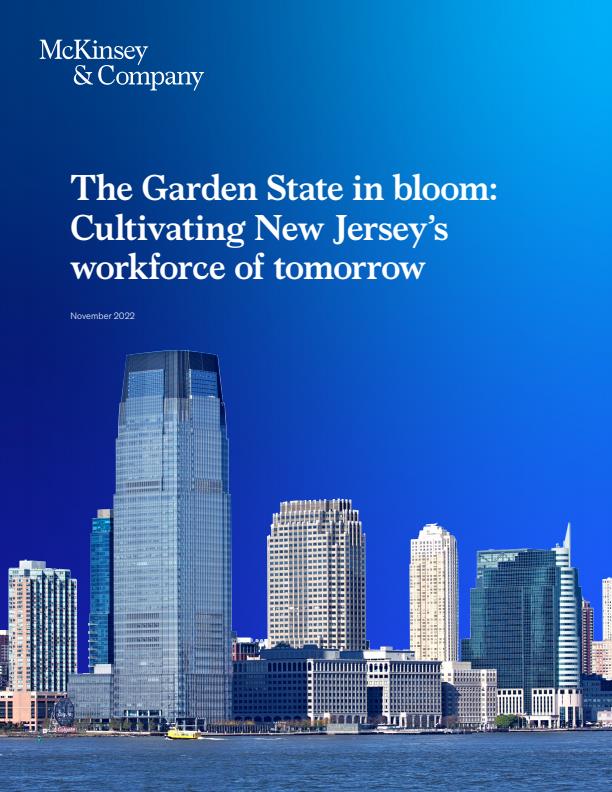Over the past several years, all US states had to respond to the sudden, dramatic shocks caused by the COVID-19 pandemic. During one of the most challenging downturns of our generation, New Jersey’s economy weathered the impact of the pandemic and bounced back faster than it had in previous crises.
After the low point of the Great Recession in 2008, New Jersey spent the better part of eight years working its way back to precrisis levels, but then growth accelerated. From 2015 to 2019, the state’s GDP grew 2.4 times faster than during the 2010–15 period. The pandemic disrupted this steady growth: during the first year of the crisis, New Jersey’s economy and labor market both declined: GDP contracted by 4.6 percent, exceeding the US average of 3.4 percent.1
In addition, New Jersey’s labor market lost 717,000 jobs, with employment dropping from 4.2 million in February 2020 to 3.5 million in April 2020.2 The economic fallout from the pandemic was not equally distributed among New Jersey’s workforce. In 2020, Black and Hispanic workers were 77 and 60 percent more likely to be unemployed, respectively, than White workers.3
Despite this drop, New Jersey’s GDP bounced back to prepandemic levels in the third quarter of 2021, and the total level of employment rebounded in the third quarter of 2022. Federal and state governments undertook policies aimed at reducing the impact of the pandemic, including the Economic Recovery Act of 2020, a seven-year, $14 billion package of tax incentives, financing, and grant programs.
New Jersey’s economic growth in the second half of the past decade and the recovery from the economic effects of the COVID-10 pandemic was fueled by several foundational attributes:
An economy anchored in a set of high-growth industries
Over the past decade, a few strategic industries have made the largest contributions to the state’s employment growth: administrative, management, and business services; finance and insurance; healthcare and social assistance; professional, scientific, and technical services; and transportation and warehousing. Together, these industries employ more than 1.6 million people, accounting for 40 percent of the total nonfarm employment in the state. Those industries not only are overrepresented in New Jersey but also have grown faster than in the rest of the United States in the second part of the past decade. Together with accommodation and food services, whose growth will be fueled by its continued recovery to prepandemic levels, those industries are expected to create 130,000 jobs over the next decade, leading the charge in job creation.
A highly educated, diverse talent pool and top-tier educational and research institutions
Forty-four percent of adult residents had earned at least a bachelor’s degree as of 2020, outpacing nearly all peer states in the region and far above the US average of 34 percent.4 In 2021, New Jersey’s more than 70 higher-education institutions enrolled more than 400,000 students and conferred more than 67,000 bachelor’s and advanced degrees.5 The state’s talent engine is particularly effective in the science, technology, engineering, and math disciplines: its share of STEM graduates, at 17 percent of all graduates, ranks fourth in the country.6
A magnet for investment and research
Spurring innovation across industries requires a number of elements to be in place, from infrastructure and talent to investment capital. New Jersey has a robust network of innovation centers in the private sector, led by top global companies and promising start-ups. New Jersey ranks ninth among states for total venture capital investments, bringing in more than $9 billion from 2019 to 2021 ($5.5 billion in 2021 alone),7 a sevenfold increase on an annual basis from 2019 to 2021.
An economy with an enviable geographic position at the crossroads of commerce
Approximately $2.8 trillion in GDP is generated within 150 miles of the state,8 which has easy access to all major cities on the Eastern Seaboard. New Jersey’s air- and seaports make the state a hub for global passenger travel and shipping. In addition, the Port of New York and New Jersey, the largest port on the East Coast, is the gateway to one of the most concentrated consumer markets in North America. 9
Challenges to sustained, inclusive growth
Two barriers to the continued growth of New Jersey’s economy are a widening talent shortage and the persistent disparities in economic prosperity across all social groups. The lack of a sufficient pool of qualified workers could slow the economy’s momentum and stifle business investment. At the same time, Black and Hispanic residents have not reached the same levels of prosperity and access to quality jobs as the rest of the state’s population.
A comprehensive, inclusive talent strategy can be an engine for economic growth, helping businesses find the talent they need, creating opportunities for the underserved, and unlocking the full potential of New Jersey’s economy for all of its residents.
A persistent and growing talent gap
New Jersey has faced a talent gap—a mismatch between the demand for skilled workers and the supply—since before 2010, but the gap has increased in recent years (Exhibit 1). This talent gap could slow growth because the state’s production of qualified talent is not keeping pace with increased business development and job demand.

We analyzed the talent gap from the perspective of both workers and employers. Understanding these factors will be instrumental in crafting effective strategies to narrow New Jersey’s labor shortages.
The workers’ perspective: Labor force participation, mobility, and training
The overall supply of talent is influenced by a number of factors. The labor force participation rate for New Jersey’s working-age population (those aged 16 and above) has declined steadily over the past 10 years, from 66 percent in 2012 to 63 percent in 2022, the lowest in 44 years.10
In addition, New Jersey is a net exporter of talent: from 2011 to 2021, an average of 20,000 residents (net of inflows) migrated to other states or countries each year. Similarly, in 2020, New Jersey had a 38 percent retention rate of newly graduated college students, which trailed New York (52 percent) and Pennsylvania (45 percent).11
An added challenge is that more than half of the current talent gap is for positions that typically require some postsecondary training. These occupations account for nearly two-thirds of forecast job growth in New Jersey.12 Among the top 15 occupations with unfilled positions requiring a bachelor’s degree, 11 have at least twice as many unfilled job postings than there are graduates each year (Exhibit 2). Without a sufficient increase in graduates in healthcare, IT, and business programs, companies may face added difficulty in finding qualified talent.

The employer perspective: Practices that could potentially screen out qualified candidates
Three-quarters of US companies use automated recruiting systems, with standard filters such as degree requirements or years of experience, to sift through applications. Companies in New Jersey might be able to expand their candidate pools by adopting more flexible requirements for occupations with high levels of unfilled positions. For example, our analysis suggests New Jersey could have 330,000 to 740,000 “hidden workers”—that is, skilled individuals who are unemployed or underemployed but often find themselves blocked from consideration for higher-wage jobs, as well as those who gave up looking for work but want to reenter the labor markets.
Growing disparities in economic opportunities
Economic opportunity and outcomes aren’t equally distributed across the state’s population. Our analysis of economic outcomes in New Jersey reveals existing inequality along racial and ethnic groups and gender lines. In addition, by 2030, job displacement from automation could reach more than one million jobs—equal to almost one-quarter of the state’s labor force (Exhibit 3). Racial minorities are overrepresented in jobs that are more likely to be displaced by automation in the upcoming years.

As higher-skill occupations make up a greater share of New Jersey’s job growth and some are displaced by automation and digital technologies, both the talent gap and disparities may continue to grow. Coordinated efforts would help workers transition to in-demand, high-skilled jobs, creating an opportunity to address talent demands and build a more inclusive economy.
Disruptive trends threatening to increase talent shortages
Over the next decade, New Jersey’s labor gap could grow. At a minimum, we expect the gap will remain at around 250,000 unfilled positions; at worst, it could be close to 400,000 by 2030 and contribute to widening economic disparities in the state (Exhibit 4).

Occupations that currently require postsecondary education or higher—such as healthcare practitioners, management, computer and mathematical, and technical, business, and financial operations—will experience the highest growth through 2030. All of them already show talent shortages.
Further, the pandemic accelerated trends that are likely to continue affecting the labor market. Shifted employee expectations could add to turnover, which is already at historic high levels with more than 100,000 employees voluntarily leaving their jobs every month in the state. The situation is not likely to change, given that 40 percent of workers surveyed in our 2022 Great Attrition, Great Attraction Survey indicated they are at least somewhat likely to quit their current job in the next three to six months. Our analysis shows that higher attrition expands the talent gap, at least temporarily, and increases the need to retrain new employees.
Moreover, the role of the workplace is changing. The 2022 McKinsey American Opportunity Survey found that approximately 60 percent of New Jersey workers would work remotely three or more days a week when given the opportunity.13 Our analysis shows that up to 1.4 million jobs in New Jersey could be performed remotely, which represents 31 percent of total employment in the state. With no active efforts for retention, those workers could shift to employers in other states.
All of these trends represent a threat but also offer stakeholders an opportunity to reimagine how to attract, retain, and develop a high-quality workforce that can meet the demands of a growing economy.
Cultivating the workforce of tomorrow
New Jersey has the opportunity to alleviate the labor gap and create a dynamic, highly qualified workforce to support economic growth. Our analysis suggests that addressing the talent shortage could increase annual growth by 0.6 to 0.8 percentage points from 2022 to 2030, translating to an incremental $38 billion to $50 billion in GDP in 2030 when compared to a baseline scenario. It represents a total potential increase of $160 billion to $175 billion in GDP from 2022 to 2030.
Our research and analysis have identified five bold bets that could help New Jersey close its talent gap and create a fast-growing, inclusive economy:
- Expand capacity and enrollment in healthcare, IT, and business programs at postsecondary education institutions.
- Extend support services and incentives for students and hidden workers to join the labor force in New Jersey.
- Redefine employer hiring and recruiting processes to remove barriers for employment and actively tap into often overlooked pools of talent.
- Take the lead in creating the work environment of the future to improve attraction and retention among New Jersey’s companies.
- Strengthen the value proposition of living and working in midsize cities in New Jersey, developing ecosystems that transform urban areas into regional talent magnets.
New Jersey’s stakeholders can act now to address the underlying factors contributing to the labor gap, address inequality in employment opportunities, and improve talent retention in the state. To become a reality, this vision would need the engagement and coordinated action of New Jersey government, nonprofits, academia, and business. It’s time to get to work.
Download the full report on which this article is based, The Garden State in bloom: Cultivating New Jersey’s workforce of tomorrow.



